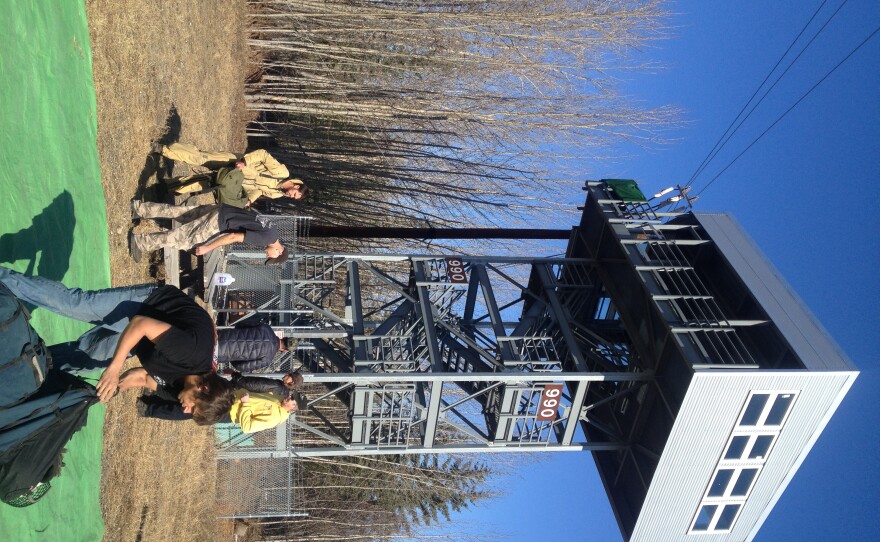Fairbanks, AK - Wildland firefighters across the country are gearing up. Many of them will battle wildfires from the ground this summer, but there’s one elite group that’s been training for three months to fight fire from the air. KUAC’s Emily Schwing caught up with the Alaska smokejumpers to find out how they train and why they do what they do.
A handful of wildland firefighters climb to the top of a three story metal tower. They’re wearing harnesses and when they reach the top, they clip onto a zipline. This smokejumping exercise simulates what it’s like to stand at the open door of an airplane. A spotter tells the first firefighter to get ready, and then starts counting down.
The smokejumper takes off across the zipline as spotter Lisa Allen watches. She says the jumper is practicing a parachute malfunction. “In stressful situations, you can become unaware really quickly of time passing and in that situation time is of the essence, so you want to stay in a very sequenced count to get a canopy up above you that’s going to save your life," she said.
Allen has been fighting wildfires all over the Western United States for close to two decades. She began her career on the ground in a hot shot crew before she took to the skies as a smokejumper.
“It’s a very efficient way to get to a fire. I love being in the sky, I love flying. I wouldn’t say I’m an adrenaline junkie but I do like the thrill of it and just the independence of it," Allen said.
Smokejumpers fight wildfires that can’t be reached from the ground: blazes that flare up far from road system and in some of the most remote parts of the country. The training is rigorous. Crew supervisor Robert Jager says it’s the most nerve wracking part. “We have to do a PT test every year and it’s not that hard, but someone is timing you and it’s for your job. So it’s pass or fail. If you don’t pass, you don’t have a job," he said.
Among other things, smokejumpers have to carry 110 pounds for three miles in less than 90 minutes. The kevlar jumpsuits they wear, combined with all the gear they carry in the field, can weigh even more than that. But after decades on the job, Jager hasn’t failed a physical fitness test yet.
“It’s always close! Even if you get it easy, it’s still hard," Jager said.
Out in a swampy field near Fairbanks, a small crowd gathers as a plane circles at 3,000 feet overhead. Smokejumpers also have to complete a series of refresher training jumps each year before they head out to fight a fire. We crane our necks as two men jump from the aircraft and steer red, white and blue parachutes toward an orange target on the ground.
This never gets old for Marty Meierotto. He’s been jumping for 22 years. “I don’t particularly like fighting fire, but I love flying and being in the woods and this is about the best job you can have to do both," Meierotto said. His seven-year-old daughter, Noah, came to watch him practice.
“I want to be a smokejumper!" she says. “I think maybe she’ll go to school and do something else," Meierotto laughs.
Smokejumpers know their job is dangerous, so they choose to talk instead about what Lisa Allen calls “thrill moments.”
“We got to jump, take care of the fire, hang out, and then get picked up by a helicopter, and go back, pack up our parachutes and do it again," she said. But even though trouble on the job is pretty rare, she says it can happen. “We had a thunder cell come over the fire and it just pretty much blew out and chased us out of our jump spot and made us run.”
From the zipline to the airplane, this is the time of year when more than 400 smokejumpers brush up on their skills here and at eight other smokejumping bases in the Western United States. They’ve been training for nearly three months for whatever the upcoming wildfire season might throw their way.







